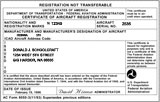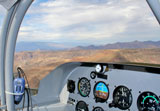|
Amateur Built Operating LimitationsOperating limitations will be designed to fit the specific situation encountered. The FAA/DAR may impose any additional limitations deemed necessary in the interest of safety. The FAA/DAR will review each imposed operating limitation with the applicant to ensure that the operating limitations are understood by the applicant. The following operating limitations will be prescribed to experimental amateur-built aircraft: 1. No person may operate this aircraft for other than the purpose of meeting the requirements of FAR 91.319(b) during phase I flight testing, and for recreation and education after meeting these requirements as stated in the program letter (required by FAR 21.193) for this aircraft. In addition, this aircraft must be operated in accordance with applicable air traffic and general operating rules of FAR 91 and all additional limitations herein prescribed under the provisions of FAR 91.319(i). These operating limitations are a part of Form 8130-7, and are to be carried in the aircraft at all times and be available to the pilot in command of the aircraft. 2. During phase I flight testing to meet the requirements of FAR 91.319(b), all flights must be conducted within the geographical area described as follows: (a) The area must be described by radius, coordinates, and/or landmarks. (b) The designated area must be over open water or sparsely populated areas having light air traffic. (c) The size of the area must be that required to safely conduct anticipated maneuvers and tests, as appropriate. 3. This aircraft must be operated for at least ______ hours in the assigned geographic area. 4. All test flights, at a minimum, must be conducted under day VFR only. Following satisfactorycompletion of the required number of flight hours in the flight test area, the pilot must certify in therecords that the aircraft has been shown to comply with FAR 91.319(b). Compliance with FAR 91.319(b) must be recorded in the aircraft records with the following, or a similarly worded, statement: “I certify that the prescribed flight test hours have been completed and the aircraft is controllable throughout itsnormal range of speeds and throughout all maneuvers to be executed, has no hazardous operating characteristics or design features, and is safe for operation. The following aircraft operating data has been demonstrated during the flight testing: speeds Vso ______, Vx ______, and Vy ______, and the weight ______ and CG location ______ at which they were obtained.” 5. Except for takeoffs and landings, this aircraft may not be operated over densely populated areas or in congested airways. 6. This aircraft is prohibited from operating in congested airways or over densely populated areas unless directed by air traffic control, or unless sufficient altitude is maintained to effect a safe emergency landing in the event of a power unit failure, without hazard to persons or property on the ground. NOTE: This limitation is applicable to the aircraft after it has satisfactorily completed all requirements for phase I flight testing, has the appropriate endorsement in the aircraft logbook and maintenance records, and is operating in phase II. 7. This aircraft is to be operated under VFR, day only. 8. After completion of phase I flight testing, unless appropriately equipped for night and/or instrument flight in accordance with FAR 91.205, this aircraft is to be operated under VFR, day only. 9. Aircraft instruments and equipment installed and used under FAR 91.205 must be inspected and maintained in accordance with the requirements of FAR 91. Any maintenance or inspection of this equipment must be recorded in the aircraft logbook and maintenance records. 10. During the flight testing phase, no person may be carried in this aircraft during flight unless that person is essential to the purpose of the flight. 11. No person may operate this aircraft for carrying persons or property for compensation or hire. 12. The pilot in command of this aircraft must advise each passenger of the experimental nature of this aircraft, and explain that it does not meet the certification requirements of a standard certificated aircraft. 13. This aircraft must contain the placards or markings, as required by FAR 91.9. In addition, the placards and markings must be inspected for legibility and clarity, and the associated systems inspected for easy access and operation, to ensure they function as intended by the amateur builder/owner during each condition inspection. 14. This aircraft must display the word “EXPERIMENTAL” in accordance with FAR 45.23(b). 15. This aircraft is prohibited from aerobatic flight, that is, an intentional maneuver involving an abrupt change in the aircraft’s attitude, an abnormal attitude, or abnormal acceleration not necessary for normal flight. NOTE: If the amateur builder states that the aircraft is capable of aerobatic flight, limitation 16 will be used in lieu of limitation 15. 16. This aircraft may conduct aerobatic flight in accordance with the provisions of FAR 91.303. Aerobatics must not be attempted until sufficient flight experience has been gained to establish that the aircraft is satisfactorily controllable and in compliance with FAR 91.319(b). The aircraft may only conduct those aerobatic flight maneuvers that have been satisfactorily accomplished during flight testing and recorded in the aircraft logbook and maintenance records by use of the following, or a similarly worded, statement: “I certify that the following aerobatic maneuvers have been test flown and that the aircraft is controllable throughout the maneuvers’ normal range of speeds, and is safe for operation. The flight-tested aerobatic maneuvers are _________, _________, __________, and __________.” NOTE: Applicants will be advised that aerobatics or violent maneuvers should not be attempted until sufficient flight experience has been gained to establish that the aircraft is satisfactorily controllable. The operating limitations may be modified to include only those aerobatics/maneuvers that have been satisfactorily accomplished and recorded in the aircraft records during the flight test period. 17. The pilot in command of this aircraft must hold an appropriate category/class rating. If required, the pilot in command also must hold a type rating in accordance with FAR 61, or a letter of authorization issued by an FAA Flight Standards Operations Inspector. NOTE: This limitation applies to any turbojet/turbofan-powered aircraft, any aircraft with a maximum takeoff weight exceeding 12,500 pounds, or any other aircraft when deemed necessary. 18. The pilot in command of this aircraft must hold a pilot certificate or an authorized instructor’s logbook endorsement. The pilot in command also must meet the requirements of FAR 61.31(e), (f), (g), (h), (i), and (j), as appropriate. NOTE: This operating limitation applies to most amateur-built aircraft as a standard operating limitation (reference FAR 61.31(k)). 19. After incorporating a major change as described in FAR 21.93, the aircraft owner is required to reestablish compliance with FAR 91.319(b) and notify the geographically responsible FSDO of the location of the proposed test area. The aircraft owner must obtain concurrence from the FSDO as to the suitability of the proposed test area. If the major change includes installing a different type of engine (reciprocating to turbine) or a change of a fixed-pitch from or to a controllable propeller, the aircraft owner must fill out a revised Form 8130-6 to update the aircraft’s file in the FAAAircraft Registration Branch. All operations must be conducted under day VFR conditions in a sparsely populated area. The aircraft must remain in flight test for a minimum of 5 hours. The FSDO may require additional time (more than 5 hours) depending on the extent of the modification. Persons nonessential to the flight must not be carried. The aircraft owner must make a detailed aircraft logbook and maintenance records entry describing the change before the test flight. Following satisfactory completion of the required number of flight hours in the flight test area, the pilot must certify in therecords that the aircraft has been shown to comply with FAR 91.319(b). Compliance must be recorded in the aircraft records with the following, or a similarly worded, statement: “I certify that the prescribed flight test hours have been completed and the aircraft is controllable throughout its normal range of speeds and throughout all maneuvers to be executed, has no hazardous characteristics or design features, and is safe for operation. The following aircraft operating data has been demonstrated during the flight testing: speeds Vso ______, Vx ______, and Vy ______, and the weight ______, and CG location ______ at which they were obtained.” 20. This aircraft must not be used for glider towing, banner towing, or intentional parachute jumping. 21. This aircraft does not meet the requirements of the applicable, comprehensive, and detailed airworthiness code, as provided by Annex 8 to the Convention on International Civil Aviation. The owner/operator of this aircraft must obtain written permission from another CAA before operating this aircraft in or over that country. That written permission must be carried aboard the aircraft together with the U.S. airworthiness certificate and, upon request, be made available to an FAA inspector or the CAA in the country of operation. 22. No person must operate this aircraft unless within the preceding 12 calendar months it has had a condition inspection performed in accordance with the scope and detail of FAR 43 Appendix D, or other FAA-approved programs, and was found to be in a condition for safe operation. As part of the condition inspection, cockpit instruments must be appropriately marked and needed placards installed in accordance with FAR 91.9. In addition, system-essential controls must be in good condition, securely mounted, clearly marked, and provide for ease of operation. This inspection will be recorded in the aircraft logbook and maintenance records. 23. Condition inspections must be recorded in the aircraft logbook and maintenance records showing the following, or a similarly worded, statement: “I certify that this aircraft has been inspected on [insert date] in accordance with the scope and detail of FAR 43 Appendix D, and was found to be in a condition for safe operation.” The entry will include the aircraft’s total time-in-service (cycles if appropriate), and the name, signature, certificate number, and type of certificate held by the person performing the inspection. NOTE: Limitations 24 and 25 will be issued in lieu of limitations 22 and 23 for turbine-powered amateur-built aircraft. 24. This aircraft must not be operated unless it is inspected and maintained in accordance with an inspection program selected, established, identified, and used as set forth in FAR 91.409(e) through (h). This inspection must be recorded in the aircraft logbook and maintenance records. 25. Inspections must be recorded in the aircraft logbook and maintenance records showing the following, or a similarly worded, statement: “I certify that this aircraft has been inspected on [insert date] in accordance with the scope and detail of the [identify program, title] FSDO-approved program dated ________, and found to be in a condition for safe operation.” The entry will include the aircraft’s total time-in-service (cycles if appropriate), and the name, signature, certificate number, and type of certificate held by the person performing the inspection. 26. An experimental aircraft builder certificated as a repairman for this aircraft under FAR 65.104 or an appropriately rated FAA-certificated mechanic may perform the condition inspection required by these operating limitations. 27. Application must be made to the geographically responsible FSDO or MIDO for any revision to these operating limitations. 28. The pilot in command of this aircraft must notify air traffic control of the experimental nature of this aircraft when operating into or out of airports with an operational control tower. When filing IFR, the experimental nature of this aircraft must be listed in the remarks section of the flight plan.
|









